Faisal Ahmed
RepViT-CXR: A Channel Replication Strategy for Vision Transformers in Chest X-ray Tuberculosis and Pneumonia Classification
Sep 10, 2025Abstract:Chest X-ray (CXR) imaging remains one of the most widely used diagnostic tools for detecting pulmonary diseases such as tuberculosis (TB) and pneumonia. Recent advances in deep learning, particularly Vision Transformers (ViTs), have shown strong potential for automated medical image analysis. However, most ViT architectures are pretrained on natural images and require three-channel inputs, while CXR scans are inherently grayscale. To address this gap, we propose RepViT-CXR, a channel replication strategy that adapts single-channel CXR images into a ViT-compatible format without introducing additional information loss. We evaluate RepViT-CXR on three benchmark datasets. On the TB-CXR dataset,our method achieved an accuracy of 99.9% and an AUC of 99.9%, surpassing prior state-of-the-art methods such as Topo-CXR (99.3% accuracy, 99.8% AUC). For the Pediatric Pneumonia dataset, RepViT-CXR obtained 99.0% accuracy, with 99.2% recall, 99.3% precision, and an AUC of 99.0%, outperforming strong baselines including DCNN and VGG16. On the Shenzhen TB dataset, our approach achieved 91.1% accuracy and an AUC of 91.2%, marking a performance improvement over previously reported CNN-based methods. These results demonstrate that a simple yet effective channel replication strategy allows ViTs to fully leverage their representational power on grayscale medical imaging tasks. RepViT-CXR establishes a new state of the art for TB and pneumonia detection from chest X-rays, showing strong potential for deployment in real-world clinical screening systems.
HOG-CNN: Integrating Histogram of Oriented Gradients with Convolutional Neural Networks for Retinal Image Classification
Jul 29, 2025Abstract:The analysis of fundus images is critical for the early detection and diagnosis of retinal diseases such as Diabetic Retinopathy (DR), Glaucoma, and Age-related Macular Degeneration (AMD). Traditional diagnostic workflows, however, often depend on manual interpretation and are both time- and resource-intensive. To address these limitations, we propose an automated and interpretable clinical decision support framework based on a hybrid feature extraction model called HOG-CNN. Our key contribution lies in the integration of handcrafted Histogram of Oriented Gradients (HOG) features with deep convolutional neural network (CNN) representations. This fusion enables our model to capture both local texture patterns and high-level semantic features from retinal fundus images. We evaluated our model on three public benchmark datasets: APTOS 2019 (for binary and multiclass DR classification), ORIGA (for Glaucoma detection), and IC-AMD (for AMD diagnosis); HOG-CNN demonstrates consistently high performance. It achieves 98.5\% accuracy and 99.2 AUC for binary DR classification, and 94.2 AUC for five-class DR classification. On the IC-AMD dataset, it attains 92.8\% accuracy, 94.8\% precision, and 94.5 AUC, outperforming several state-of-the-art models. For Glaucoma detection on ORIGA, our model achieves 83.9\% accuracy and 87.2 AUC, showing competitive performance despite dataset limitations. We show, through comprehensive appendix studies, the complementary strength of combining HOG and CNN features. The model's lightweight and interpretable design makes it particularly suitable for deployment in resource-constrained clinical environments. These results position HOG-CNN as a robust and scalable tool for automated retinal disease screening.
Robust Five-Class and binary Diabetic Retinopathy Classification Using Transfer Learning and Data Augmentation
Jul 23, 2025Abstract:Diabetic retinopathy (DR) is a leading cause of vision loss worldwide, and early diagnosis through automated retinal image analysis can significantly reduce the risk of blindness. This paper presents a robust deep learning framework for both binary and five-class DR classification, leveraging transfer learning and extensive data augmentation to address the challenges of class imbalance and limited training data. We evaluate a range of pretrained convolutional neural network architectures, including variants of ResNet and EfficientNet, on the APTOS 2019 dataset. For binary classification, our proposed model achieves a state-of-the-art accuracy of 98.9%, with a precision of 98.6%, recall of 99.3%, F1-score of 98.9%, and an AUC of 99.4%. In the more challenging five-class severity classification task, our model obtains a competitive accuracy of 84.6% and an AUC of 94.1%, outperforming several existing approaches. Our findings also demonstrate that EfficientNet-B0 and ResNet34 offer optimal trade-offs between accuracy and computational efficiency across both tasks. These results underscore the effectiveness of combining class-balanced augmentation with transfer learning for high-performance DR diagnosis. The proposed framework provides a scalable and accurate solution for DR screening, with potential for deployment in real-world clinical environments.
FedAuxHMTL: Federated Auxiliary Hard-Parameter Sharing Multi-Task Learning for Network Edge Traffic Classification
Apr 11, 2024Abstract:Federated Learning (FL) has garnered significant interest recently due to its potential as an effective solution for tackling many challenges in diverse application scenarios, for example, data privacy in network edge traffic classification. Despite its recognized advantages, FL encounters obstacles linked to statistical data heterogeneity and labeled data scarcity during the training of single-task models for machine learning-based traffic classification, leading to hindered learning performance. In response to these challenges, adopting a hard-parameter sharing multi-task learning model with auxiliary tasks proves to be a suitable approach. Such a model has the capability to reduce communication and computation costs, navigate statistical complexities inherent in FL contexts, and overcome labeled data scarcity by leveraging knowledge derived from interconnected auxiliary tasks. This paper introduces a new framework for federated auxiliary hard-parameter sharing multi-task learning, namely, FedAuxHMTL. The introduced framework incorporates model parameter exchanges between edge server and base stations, enabling base stations from distributed areas to participate in the FedAuxHMTL process and enhance the learning performance of the main task-network edge traffic classification. Empirical experiments are conducted to validate and demonstrate the FedAuxHMTL's effectiveness in terms of accuracy, total global loss, communication costs, computing time, and energy consumption compared to its counterparts.
MM-VID: Advancing Video Understanding with GPT-4V
Oct 30, 2023Abstract:We present MM-VID, an integrated system that harnesses the capabilities of GPT-4V, combined with specialized tools in vision, audio, and speech, to facilitate advanced video understanding. MM-VID is designed to address the challenges posed by long-form videos and intricate tasks such as reasoning within hour-long content and grasping storylines spanning multiple episodes. MM-VID uses a video-to-script generation with GPT-4V to transcribe multimodal elements into a long textual script. The generated script details character movements, actions, expressions, and dialogues, paving the way for large language models (LLMs) to achieve video understanding. This enables advanced capabilities, including audio description, character identification, and multimodal high-level comprehension. Experimental results demonstrate the effectiveness of MM-VID in handling distinct video genres with various video lengths. Additionally, we showcase its potential when applied to interactive environments, such as video games and graphic user interfaces.
Towards Zero-power 3D Imaging: VLC-assisted Passive ToF Sensing
Jul 17, 2023


Abstract:Passive Time-of-Flight (ToF) imaging can be enabled by optical wireless communication (OWC). The lighting infrastructure is the backbone of emerging light-based wireless communication. To this end, communication sources are used as opportunity illuminators to probe the scene, and an array of time-resolved pixels are exploited to demodulate the return, provided that the ToF camera can be externally synchronized. Our work employs a direct line-of-sight path to synchronize the camera externally. Together with the indirect path given by the reflections from the scene, this yields a bistatic configuration. Each Time-of-Flight (ToF) measurement induced a solution space of ellipsoidal shape and redefined the image formation model based on the bistatic configuration. In this demo, we showcase a passive ToF camera capable of delivering intensity and depth information in practice without emitting photons from the ToF camera. Our passive modality can eliminate built-in illumination sources, thus coping with optical power constraints, as is desired in future ToF cameras.
MM-REACT: Prompting ChatGPT for Multimodal Reasoning and Action
Mar 20, 2023



Abstract:We propose MM-REACT, a system paradigm that integrates ChatGPT with a pool of vision experts to achieve multimodal reasoning and action. In this paper, we define and explore a comprehensive list of advanced vision tasks that are intriguing to solve, but may exceed the capabilities of existing vision and vision-language models. To achieve such advanced visual intelligence, MM-REACT introduces a textual prompt design that can represent text descriptions, textualized spatial coordinates, and aligned file names for dense visual signals such as images and videos. MM-REACT's prompt design allows language models to accept, associate, and process multimodal information, thereby facilitating the synergetic combination of ChatGPT and various vision experts. Zero-shot experiments demonstrate MM-REACT's effectiveness in addressing the specified capabilities of interests and its wide application in different scenarios that require advanced visual understanding. Furthermore, we discuss and compare MM-REACT's system paradigm with an alternative approach that extends language models for multimodal scenarios through joint finetuning. Code, demo, video, and visualization are available at https://multimodal-react.github.io/
SwinBERT: End-to-End Transformers with Sparse Attention for Video Captioning
Nov 25, 2021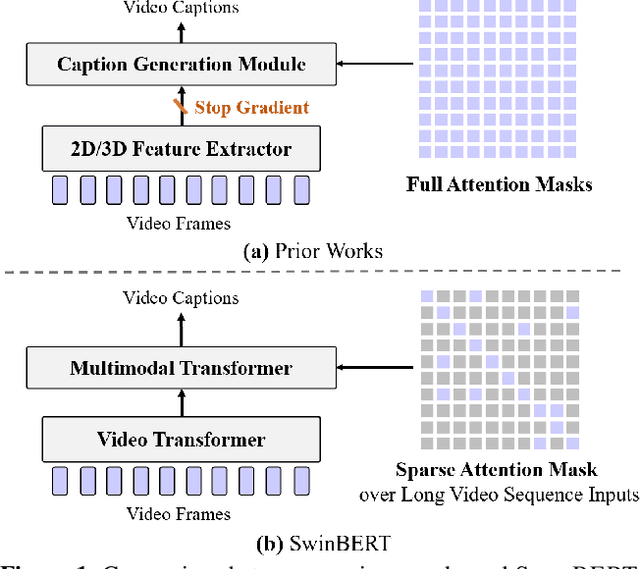


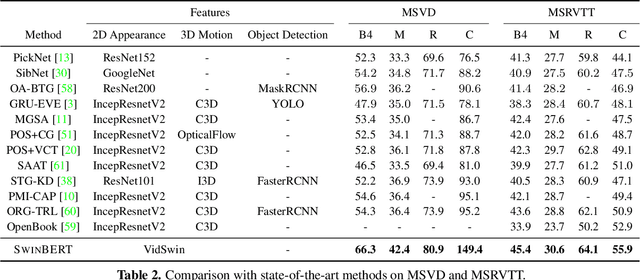
Abstract:The canonical approach to video captioning dictates a caption generation model to learn from offline-extracted dense video features. These feature extractors usually operate on video frames sampled at a fixed frame rate and are often trained on image/video understanding tasks, without adaption to video captioning data. In this work, we present SwinBERT, an end-to-end transformer-based model for video captioning, which takes video frame patches directly as inputs, and outputs a natural language description. Instead of leveraging multiple 2D/3D feature extractors, our method adopts a video transformer to encode spatial-temporal representations that can adapt to variable lengths of video input without dedicated design for different frame rates. Based on this model architecture, we show that video captioning can benefit significantly from more densely sampled video frames as opposed to previous successes with sparsely sampled video frames for video-and-language understanding tasks (e.g., video question answering). Moreover, to avoid the inherent redundancy in consecutive video frames, we propose adaptively learning a sparse attention mask and optimizing it for task-specific performance improvement through better long-range video sequence modeling. Through extensive experiments on 5 video captioning datasets, we show that SwinBERT achieves across-the-board performance improvements over previous methods, often by a large margin. The learned sparse attention masks in addition push the limit to new state of the arts, and can be transferred between different video lengths and between different datasets.
Crossing the Format Boundary of Text and Boxes: Towards Unified Vision-Language Modeling
Nov 23, 2021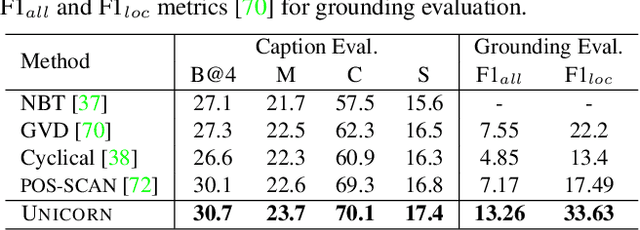
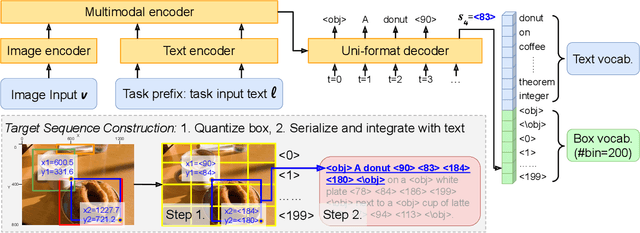


Abstract:In this paper, we propose UNICORN, a vision-language (VL) model that unifies text generation and bounding box prediction into a single architecture. Specifically, we quantize each box into four discrete box tokens and serialize them as a sequence, which can be integrated with text tokens. We formulate all VL problems as a generation task, where the target sequence consists of the integrated text and box tokens. We then train a transformer encoder-decoder to predict the target in an auto-regressive manner. With such a unified framework and input-output format, UNICORN achieves comparable performance to task-specific state of the art on 7 VL benchmarks, covering the visual grounding, grounded captioning, visual question answering, and image captioning tasks. When trained with multi-task finetuning, UNICORN can approach different VL tasks with a single set of parameters, thus crossing downstream task boundary. We show that having a single model not only saves parameters, but also further boosts the model performance on certain tasks. Finally, UNICORN shows the capability of generalizing to new tasks such as ImageNet object localization.
UNITER: Learning UNiversal Image-TExt Representations
Sep 25, 2019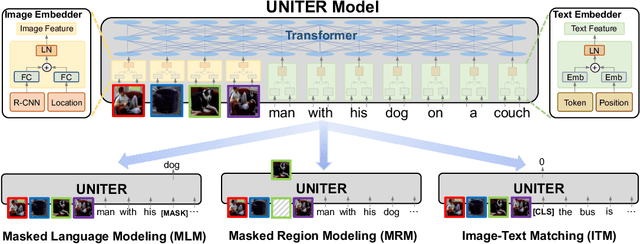


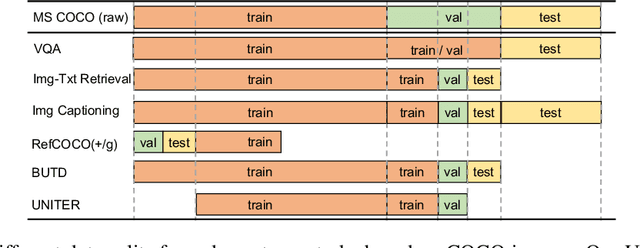
Abstract:Joint image-text embedding is the bedrock for most Vision-and-Language (V+L) tasks, where multimodality inputs are jointly processed for visual and textual understanding. In this paper, we introduce UNITER, a UNiversal Image-TExt Representation, learned through large-scale pre-training over four image-text datasets (COCO, Visual Genome, Conceptual Captions, and SBU Captions), which can power heterogeneous downstream V+L tasks with joint multimodal embeddings. We design three pre-training tasks: Masked Language Modeling (MLM), Image-Text Matching (ITM), and Masked Region Modeling (MRM, with three variants). Different from concurrent work on multimodal pre-training that apply joint random masking to both modalities, we use conditioned masking on pre-training tasks (i.e., masked language/region modeling is conditioned on full observation of image/text). Comprehensive analysis shows that conditioned masking yields better performance than unconditioned masking. We also conduct a thorough ablation study to find an optimal setting for the combination of pre-training tasks. Extensive experiments show that UNITER achieves new state of the art across six V+L tasks (over nine datasets), including Visual Question Answering, Image-Text Retrieval, Referring Expression Comprehension, Visual Commonsense Reasoning, Visual Entailment, and NLVR2.
 Add to Chrome
Add to Chrome Add to Firefox
Add to Firefox Add to Edge
Add to Edge